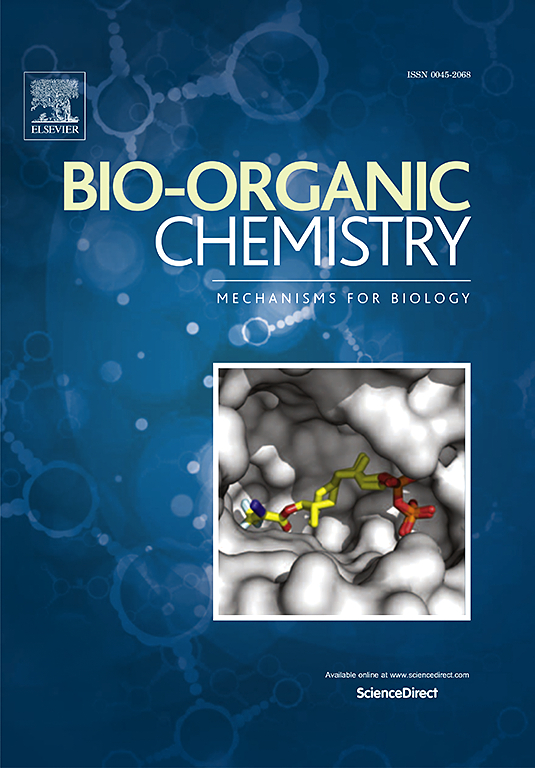针对nur77介导的内质网应激的N1-(2-(金刚烷-1-基)- 1h -吲哚-5-基)- n2 -(取代基)-1,2-二羧基酰胺抗癌药物的设计、合成和生物学评价
IF 4.5
2区 医学
Q1 BIOCHEMISTRY & MOLECULAR BIOLOGY
引用次数: 0
摘要
靶向内质网应激诱导的细胞凋亡在抗癌药物开发中引起了广泛的研究兴趣。Nur77是许多癌症的潜在治疗靶点,一些Nur77调节剂最近被确定为通过激活内质网应激而有效的抗癌药物。作为一项正在进行的工作,本研究报道了一系列新的N1-(2-(金刚烷-1-基)- 1h -吲哚-5-基)- n2 -(取代基)-1,2-二羧基酰胺作为有效的Nur77调节剂,引起内质网应激诱导的细胞凋亡。在这个新系列中,大多数化合物对肝癌(HepG2和Huh7)和乳腺癌(MCF-7和MDA-MB-231)细胞系的细胞毒性都有提高。代表性模拟物15h显著诱导Nur77表达和细胞凋亡,对HepG2和MCF-7细胞表现出良好的生长抑制作用(IC50 D = 0.477 μM),并通过PERK-ATF4和IRE1信号通路激活Nur77介导的内质网应激,从而诱导细胞凋亡。在体内,15h治疗强烈抑制HepG2异种移植物肿瘤的生长(肿瘤缩小54.06%)。综上所述,我们合成了一系列新的吲哚衍生物,其中15h对多种癌细胞的药理活性显著提高。我们进一步发现15h是Nur77的一个新的配体,它可能为开发新的癌症治疗方法提供治疗先导。本文章由计算机程序翻译,如有差异,请以英文原文为准。

Design, synthesis, and biological evaluation of N1-(2-(adamantan-1-yl)-1H-indol-5-yl)-N2-(substituent)-1,2-dicarboxamides as anticancer agents targeting Nur77-mediated endoplasmic reticulum stress
Targeting endoplasmic reticulum (ER) stress-induced apoptosis has attracted considerable research interest in anti-cancer drug development. Nur77 is a potential therapeutic target in many cancers and several Nur77 modulators have recently been identified as effective anticancer agents by activating ER stress. As an ongoing work, this study reports a new series of novel N1-(2-(adamantan-1-yl)-1H-indol-5-yl)-N2-(substituent)-1,2-dicarboxamides as potent Nur77 modulators that cause ER stress-induced apoptosis. Among this new series, most compounds show improved cytotoxicity against liver cancer (HepG2 and Huh7) and breast cancer (MCF-7 and MDA-MB-231) cell lines. The representative analog 15h dramatically induces Nur77 expression and cell apoptosis, showing excellent growth inhibition of HepG2 and MCF-7 cells (IC50 < 5.0 μM). Mechanistically, 15h binds (KD = 0.477 μM) and activates Nur77-mediated ER stress through the PERK-ATF4 and IRE1 signaling pathways, thereby inducing cell apoptosis. In vivo, 15h treatment strongly suppresses HepG2 xenograft tumor growth (tumor shrink by 54.06 %). In summary, we synthesize a series of novel indole derivatives, among which 15h has significantly improved pharmacological activity against various cancer cells. We further identify 15h as a novel ligand of Nur77, which may serve a therapeutic lead for developing new cancer therapy.
求助全文
通过发布文献求助,成功后即可免费获取论文全文。
去求助
来源期刊

Bioorganic Chemistry
生物-生化与分子生物学
CiteScore
9.70
自引率
3.90%
发文量
679
审稿时长
31 days
期刊介绍:
Bioorganic Chemistry publishes research that addresses biological questions at the molecular level, using organic chemistry and principles of physical organic chemistry. The scope of the journal covers a range of topics at the organic chemistry-biology interface, including: enzyme catalysis, biotransformation and enzyme inhibition; nucleic acids chemistry; medicinal chemistry; natural product chemistry, natural product synthesis and natural product biosynthesis; antimicrobial agents; lipid and peptide chemistry; biophysical chemistry; biological probes; bio-orthogonal chemistry and biomimetic chemistry.
For manuscripts dealing with synthetic bioactive compounds, the Journal requires that the molecular target of the compounds described must be known, and must be demonstrated experimentally in the manuscript. For studies involving natural products, if the molecular target is unknown, some data beyond simple cell-based toxicity studies to provide insight into the mechanism of action is required. Studies supported by molecular docking are welcome, but must be supported by experimental data. The Journal does not consider manuscripts that are purely theoretical or computational in nature.
The Journal publishes regular articles, short communications and reviews. Reviews are normally invited by Editors or Editorial Board members. Authors of unsolicited reviews should first contact an Editor or Editorial Board member to determine whether the proposed article is within the scope of the Journal.
 求助内容:
求助内容: 应助结果提醒方式:
应助结果提醒方式:


